#performance catalyst
Explore tagged Tumblr posts
Text
1 note
·
View note
Text
I'll be honest, these recent developments are great for the fic I'm working on 😌😌
#i'm not gonna tag this you know what show im talking about LMAO#idk i just find a lot of peace and comfort in treating canon as a guideline to how i characterize them in my head#i cancel out the shit i don't wanna deal with etc.#canon is technically real but it's still fictional so how is it TRULY more real than the fic we're writing?#is it because the actors play out one specific timeline/plot?#anyway#soulbond AU where Eddie is in Texas and he and Buck are going a little insane and more than a little sick for each other while in DenialTM#Buck realizes they're “cursed” first and Eddie laughs in his face etc.#Buck meets a bunch of witches in LA some of whom are ummm y'know the woo woo crystal buttplug kind sorry I WILL have fun with this#(for the 1988 ppl I described the first person he's gonna run into as LA witch Jonny)#and finally meets a woman who takes one look at him and she's like mmm yeah you've been cursed#buck: THANK YOU IVE BEEN TELLING EDDIE THIS FOR WEEKS#her: ahaha well technically it's not a curse but...#but alo they find out it's freak binding soulbond magic because they somehow performed a ritual when buck was saving eddie's life after the#shooting and didn't realize until Eddie moved away because they did nothing that challenged that bond because they're just... y'know. SO ga#udffjfjfdkjsfg idk Eddie realizing something's wrong and then being unable to reach Buck and then hearing Bobby's dead would be excellent o#also a nice catalyst#sorry just rambling here I am 😈😈😈😈😈😈
3 notes
·
View notes
Text
apparently the reason may december is being snubbed during awards season is because a lot of actors REALLY didn’t like what it had to say about actors who take on the roles of real people, and the idea that a bunch of former theatre kids might be sensitive about criticism of the industry they work in is, to me, just so shocking
#hey guess what every industry has problems but the answer is not to ignore and snub people who comment on them#also#it almost seems wilful because for me the main takeaway was uhhh abusing kids is bad??#a white woman was able to continue abusing a boy/man of colour by infantilising herself to him and the entire world#like the natalie portman as an actress thing seemed more the catalyst of other things in the film than the main point#the whole media circus and the desire of the public to know every detail is kind of secondary to watching this young man#—who in so many ways still behaves and thinks of himself like a child—come to terms with the fact he’s been lied to and failed#just utterly failed by everyone who supposedly is there to protect him#idk i really liked it and charles melton deserves an oscar for that performance#reggie from riverdale held his own against julianne moore and natalie portman like holy shit#something something charles melton’s character never had his own voice as a child and now as a grown man still doesn’t#he is spoken over by his wife/abuser and by the media who document/frame/characterise his history and now by natalie portman’s film#may december#aj abstractions
12 notes
·
View notes
Note
4: a song that reminds you of a person you'd rather forget
Be Nice To Me by The Front Bottoms
#ray's tag#answered#shoutout to this song for being the catalyst for us realizing we were in a really shitty situation#thank you the front bottoms for writing and performing it#also Would You Mind by Friday Pilots Club#which fun fact is the song that introduced us to this band! which is now probably our favorite band of all time! :D#we used to not be able to listen to either of these due to the Associations tm but we grew past it thankfully#theyre very good songs. its not their fault theyre associated with the absolute shitshow that was that relationship#anyways
3 notes
·
View notes
Text
Bastard Acquired
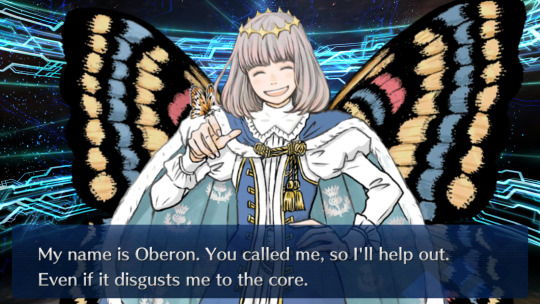
#Fate/Grand Order#fgo#I learned he was up during my lunch break and spent the rest of the work day v i b r a t i n g.#My catalyst was pulling a Morgan (read: rewatching Myst's Oberon Saga and rayshifting my bad luck back for him to deal with).#Also listening to--I kid you not--King of the Fairies (performed by Katy Adelson if you want to listen to it yourself).
5 notes
·
View notes
Text
Andy Nightingale, VP of Product Marketing at Arteris – Interview Series
New Post has been published on https://thedigitalinsider.com/andy-nightingale-vp-of-product-marketing-at-arteris-interview-series/
Andy Nightingale, VP of Product Marketing at Arteris – Interview Series


Andy Nightingale, VP of Product Marketing at Arteris is a seasoned global business leader with a diverse background in engineering and product marketing. He’s a Chartered Member of the British Computer Society and the Chartered Institute of Marketing, and has over 35 years of experience in the high-tech industry.
Throughout his career, Andy has held a range of roles, including engineering and product management positions at Arm, where he spent 23 years. In his current role as VP of product marketing at Arteris, Andy oversees the Magillem system-on-chip deployment tooling and FlexNoC and Ncore network-on-chip products.
Arteris is a catalyst for system-on-chip (SoC) innovation as the leading provider of semiconductor system IP for the acceleration of SoC development. Arteris Network-on-Chip (NoC) interconnect intellectual property (IP) and SoC integration technology enable higher product performance with lower power consumption and faster time to market, delivering proven flexibility and better economics for system and semiconductor companies, so innovative brands are free to dream up what comes next.
With your extensive experience at Arm and now leading product management at Arteris, how has your perspective on the evolution of semiconductor IP and interconnect technologies changed over the years? What key trends excite you the most today?
It’s been an extraordinary journey—from my early days writing test benches for ASICs at Arm to helping shape product strategy at Arteris, where we’re at the forefront of interconnect IP innovation. Back in 1999, system complexity rapidly accelerated, but the focus was still primarily on processor performance and essential SoC integration. Verification methodologies were evolving, but interconnect was often seen as a fixed infrastructure—necessary but not strategic.
Fast-forward to today and interconnect IP has become a critical enabler of SoC (System-on-Chip) scalability, power efficiency, and AI/ML performance. The rise of chiplets, domain-specific accelerators, and multi-die architectures has placed immense pressure on interconnect technologies to become more adaptive, innovative, physically, and software-aware.
One of the most exciting trends I see is the convergence of AI and interconnect design. At Arteris, we’re exploring how machine learning can optimize NoC (Network-on-Chip) topologies, intelligently route data traffic, and even anticipate congestion to improve real-time performance. This is not just about speed—it’s about making systems more innovative and responsive.
What excites me is how semiconductor IP is becoming more accessible to AI innovators. With high-level SoC configuration IP and abstraction layers, startups in automotive, robotics, and edge AI can now leverage advanced interconnect architectures without needing a deep background in RTL design. That democratization of capability is enormous.
Another key shift is the role of virtual prototyping and system-level modeling. Having worked on ESL (Electronic System Level) tools early in my career, it’s rewarding to see those methodologies now enabling early AI workload evaluation, performance prediction, and architectural trade-offs long before silicon is taped out.
Ultimately, the future of AI depends on how efficiently we move data—not just how fast we process it. That’s why I believe the evolution of interconnect IP is central to the next generation of intelligent systems. Arteris’ FlexGen leverages AI driven automation and machine learning to automate NoC (Network-on-Chip) topology generation. How do you see AI’s role evolving in chip design over the next five years?
AI is fundamentally transforming chip design, and over the next five years, its role will only deepen—from productivity aid to intelligent design partner. At Arteris, we’re already living that future with FlexGen, where AI, formal methods, and machine learning are central to automating Network-on-Chip (NoC) topology optimization and SoC integration workflows.
What sets FlexGen apart is its blend of ML algorithms—all combined to initialize floorplans from images, generate topologies, configure clocks, reduce Clock Domain Crossings, and optimize the connectivity topology and its placement and routing bandwidth, streamlining communication between IP blocks. Moreover, this is all done deterministically, meaning that results can be replicated and incremental adjustments made, enabling predictable best-in-class results for use cases ranging from AI assistance for an expert SoC designer to creating the right NoC for a novice.
Over the next five years, AI’s role in chip design will shift from assisting human designers to co-designing and co-optimizing with them—learning from every iteration, navigating design complexity in real-time, and ultimately accelerating the delivery of AI-ready chips. We see AI not just making chips faster but making faster chips smarter.
The semiconductor industry is witnessing rapid innovation with AI, HPC, and multi-die architectures. What are the biggest challenges that NoC design needs to solve to keep up with these advancements?
As AI, HPC, and multi-die architectures drive unprecedented complexity, the biggest challenge for NoC design is scalability without sacrificing power, performance, or time to market. Today’s chips feature tens to hundreds of IP blocks, each with different bandwidth, latency, and power needs. Managing this diversity—across multiple dies, voltage domains, and clock domains—requires NoC solutions that go far beyond manual methods.
NoC solution technologies such as FlexGen help address key bottlenecks: minimizing wire length, maximizing bandwidth, aligning with physical constraints, and doing everything with speed and repeatability.
The future of NoC must also be automation-first and AI-enabled, with tools that can adapt to evolving floorplans, chipset-based architectures, and late-stage changes without requiring complete rework. This is the only way to keep pace with modern SoCs’ massive design cycles and heterogeneous demands and ensure efficient, scalable connectivity at the heart of next-gen semiconductors.
The AI chipset market is projected to grow significantly. How does Arteris position itself to support the increasing demands of AI workloads, and what unique advantages does FlexGen offer in this space?
Arteris is not only uniquely positioned to support the AI chiplet market but has been doing this already for years by delivering automated, scalable Network-on-Chip (NoC) IP solutions purpose-built for the demands of AI workloads including Generative AI and Large Language Models (LLM) compute —supporting high bandwidth, low latency, and power efficiency across increasingly complex architectures. FlexGen, as the newest addition to the Arteris NoC IP lineup, will play an even more significant role in rapidly creating optimal topologies best suited for different large-scale, heterogeneous SoCs.
FlexGen offers incremental design, partial completion mode, and advanced pathfinding to dynamically optimize NoC configurations without complete redesigns—critical for AI chips that evolve throughout development.
Our customers are already building Arteris technology into multi-die and chiplet-based systems, efficiently routing traffic while respecting floorplan and clock domain constraints on each chiplet. Non-coherent multi-die connectivity is supported over industry-standard interfaces provided by third- party controllers.
As AI chip complexity grows, so does the need for automation, adaptability, and speed. FlexGen delivers all three, helping teams build smarter interconnects—faster—so they can focus on what matters: advancing AI performance at scale.
With the rise of RISC-V and custom silicon for AI, how does Arteris’ approach to NoC design differ from traditional interconnect architectures?
Traditional interconnect architectures were primarily built for fixed-function designs, but today’s RISC-V and custom AI silicon demand a more configurable, scalable, and automated approach than a modified one-size-fits-all solution. That’s where Arteris stands apart. Our NoC IP, especially with FlexGen, is designed to adapt to the diversity and modularity of modern SoCs, including custom cores, accelerators, and chiplets, as mentioned above.
FlexGen enables designers to generate and optimize topologies that reflect unique workload characteristics, whether low-latency paths for AI inference or high-bandwidth routes for shared memory across RISC-V clusters. Unlike static interconnects, FlexGen’s algorithms tailor each NoC to the chip’s architecture across clock domains, voltage islands, and floorplan constraints.
As a result, Arteris enables teams building custom silicon to move faster, reduce risk, and get the most from their highly differentiated designs—something traditional interconnects weren’t built to handle.
FlexGen claims a 10x improvement in design iteration speed. Can you walk us through how this automation reduces complexity and accelerates time-to-market for System-on-Chip (SoC) designers?
FlexGen delivers a 10x improvement in design iteration speed by automating some of the most complex and time-consuming tasks in NoC design. Instead of manually configuring topologies, resolving clock domains, or optimizing routes, designers use FlexGen’s physically aware, AI-powered engine to handle these in hours (or less)—tasks that traditionally took weeks.
As mentioned above, partial completion mode can automatically finish even partially completed designs, preserving manual intent while accelerating timing closure.
The result is a faster, more accurate, and easier-to-iterate design flow, enabling SoC teams to explore more architectural options, respond to late-stage changes, and get to market faster—with higher-quality results and less risk of costly rework.
One of FlexGen’s standout features is wire length reduction, which improves power efficiency. How does this impact overall chip performance, particularly in power-sensitive applications like edge AI and mobile computing?
Wire length directly impacts power consumption, latency, and overall chip efficiency—both in cloud AI / HPC applications that use the more advanced nodes and edge AI inference applications where every milliwatt matters. FlexGen’s ability to automatically minimize wire length—often up to 30%—means shorter data paths, reduced capacitance, and less dynamic power draw.
In real-world terms, this translates to lower heat generation, longer battery life, and better performance-per-watt, all of which are critical for AI workloads at the edge or in mobile environments and the cloud by directly impacting the total cost of ownership (TCO). By optimizing the NoC topology with AI-guided placement and routing, FlexGen ensures that performance targets are met without sacrificing power efficiency—making it an ideal fit for today and tomorrow’s energy-sensitive designs.
Arteris has partnered with leading semiconductor companies in AI data centers, automotive, consumer, communications, and industrial electronics. Can you share insights on how FlexGen is being adopted across these industries?
Arteris NoC IP sees strong adoption across all markets, particularly for high-end, more advanced chiplets and SoCs. That is because it addresses each sector’s top challenges: performance, power efficiency, and design complexity while preserving the core functionality and area constraints.
In automotive, for example, companies like Dream Chip use FlexGen to speed up the intersection of AI and Safety for autonomous driving by leveraging Arteris for their ADAS SoC design while meeting strict power and safety constraints. FlexGen’s smart NoC optimization and generation in data centers help manage massive bandwidth demands and scalability, especially for AI training and overall acceleration workloads.
FlexGen provides a fast, repeatable path to optimized NoC architectures for industrial electronics, where design cycles are tight and product longevity is key. Customers value its incremental design flow, AI-based optimization, and ability to adapt quickly to evolving requirements, making FlexGen a cornerstone for next-generation SoC development.
The semiconductor supply chain has faced significant disruptions in recent years. How is Arteris adapting its strategy to ensure Network-on-Chip (NoC) solutions remain accessible and scalable despite these challenges?
Arteris responds to supply chain disruptions by doubling down on what makes our NoC solutions resilient and scalable: automation, flexibility, and ecosystem compatibility.
FlexGen helps customers design faster and remain more agile to adjust to changing silicon availability, node shifts, or packaging strategies. Whether they are doing derivative designs or creating new interconnects from scratch.
We also support customers with different process nodes, IP vendors, and design environments, ensuring customers can deploy Arteris solutions regardless of their foundry, EDA tools, or SoC architecture.
By reducing dependency on any one part of the supply chain and enabling faster, iterative design, we’re helping customers derisk their designs and stay on schedule —even in uncertain times.
Looking ahead, what are the biggest shifts you anticipate in SoC development, and how is Arteris preparing for them?
One of the most significant shifts in SoC development is the move toward heterogeneous architectures, chiplet-based designs, and AI-centric workloads. These trends demand far more flexible, scalable, and intelligent interconnects—something traditional methods can’t keep up with.
Arteris is preparing by investing in AI-driven automation, as seen in FlexGen, and expanding support for multi-die systems, complex clock/power domains, and late-stage floorplan changes. We’re also focused on enabling incremental design, faster iteration, and seamless IP integration—so our customers can keep pace with shrinking development cycles and rising complexity.
Our goal is to ensure SoC (and chiplet) teams stay agile, whether they’re building for edge AI, cloud AI, or anything in between, all while providing the best power, performance, and area (PPA) no matter the complexity of the design, XPU architecture, and foundry node used.
Thank you for the great interview, readers who wish to learn more should visit Arteris.
#accelerators#adoption#agile#ai#AI assistance#AI chip#AI chips#ai inference#AI performance#ai training#AI-powered#AI/ML#Algorithms#applications#approach#architecture#arm#Arteris#automation#automotive#autonomous#autonomous driving#background#battery#battery life#brands#Building#Business#career#catalyst
0 notes
Text
Refinery Catalyst Market: Driving Efficiency, Sustainability, and Growth in Energy and Industry

In the rapidly evolving energy landscape, refinery catalysts are critical to refining crude oil into high-quality products such as gasoline, diesel, and jet fuel. Beyond efficiency, they help refineries meet stricter environmental standards and reduce operational costs. As global energy demands rise and regulations tighten, the refinery catalyst market continues to innovate, creating opportunities for sectors such as oil & gas, automotive, and environmental industries.
Market Overview
The refinery catalyst market is experiencing steady growth, fueled by a heightened focus on sustainability, operational efficiency, and regulatory compliance. The global refinery catalyst market is valued at USD 5.6 billion in 2024 and is projected to reach USD 6.8 billion by 2029, growing at 4.0% cagr from 2024 to 2029. The key categories of catalysts include:
FCC (Fluid Catalytic Cracking) Catalysts: Widely used to break heavy hydrocarbons into lighter, more valuable products like gasoline and propylene.
Hydrotreating Catalysts: Remove impurities such as sulfur and nitrogen, ensuring fuel meets ultra-low sulfur standards.
Hydrocracking Catalysts: Convert heavy hydrocarbons into cleaner fuels, such as kerosene and diesel.
Catalytic Reforming Catalysts: Increase the octane rating of fuels, meeting the performance needs of modern engines.
Key Drivers of Growth
1. Increasing Energy Demand
As developing economies grow, their energy consumption surges, creating a higher demand for refined products. Refinery catalysts enable refiners to maximize output and quality, making them essential tools in addressing this demand.
2. Stricter Environmental Standards
Governments worldwide are implementing more rigorous emission standards, such as Euro 6 and IMO 2020 low-sulfur marine fuel regulations. Advanced hydrotreating and hydrocracking catalysts help refineries produce cleaner fuels to comply with these mandates, particularly for automotive and shipping industries.
3. Petrochemical Industry Growth
Beyond fuel, catalysts are integral to producing petrochemicals like ethylene and propylene, which are foundational to plastics, textiles, and specialty chemicals. As these industries expand, so does the need for advanced catalytic processes.
4. Technological Innovations
The introduction of nano-based catalysts and other high-performance technologies has revolutionized the market. These advancements provide greater efficiency, selectivity, and durability, reducing waste and boosting refinery productivity.
Challenges in the Market
While opportunities abound, the market faces certain hurdles:
Oil Price Volatility: Fluctuating crude oil prices impact refinery investments in catalyst upgrades.
Renewable Energy Transition: The global shift towards renewable energy sources is influencing fossil fuel dependency.
Spent Catalyst Disposal: Recycling spent catalysts, which often contain hazardous materials, remains a complex and costly process.
Emerging Trends
1. Cleaner Fuel Production
The focus on reducing carbon footprints has led to innovations in catalysts for ultra-low sulfur diesel (ULSD) and high-octane gasoline production. These are crucial for reducing emissions in the automotive sector.
2. AI Integration in Refineries
Artificial intelligence is optimizing catalyst usage and refinery operations by predicting wear, improving process efficiency, and minimizing downtime.
3. Circular Economy Practices
Catalyst manufacturers are increasingly recycling spent catalysts to recover valuable metals like platinum and palladium. These practices lower costs and align with sustainability goals.
4. Regional Dynamics
Asia-Pacific: Rapid industrialization and new refinery projects in India, China, and Southeast Asia drive significant demand.
North America: The rise of shale gas and tight oil production supports advanced catalytic processes.
Middle East & Africa: Investments in large-scale refineries and petrochemical complexes are expanding market opportunities.
Applications Across Industries
Oil & Gas: Refinery catalysts are indispensable for producing cleaner, high-quality fuels.
Automotive: The shift towards cleaner transportation fuels ties directly to the automotive industry's sustainability goals.
Catalyst Manufacturing: The demand for specialized, high-performance catalysts fosters innovation in production techniques.
Environmental Sector: Catalysts help minimize industrial emissions, contributing to global efforts to combat climate change.
Download PDF Brochure :
The refinery catalyst market serves as a cornerstone for industries striving for efficiency and sustainability. With innovations in catalytic technologies and growing adoption of eco-friendly practices, the market is not only addressing current energy challenges but also shaping a more sustainable future. For decision-makers in oil & gas, automotive, energy, and environmental industries, embracing advancements in refinery catalysts can unlock new growth opportunities and align operations with global environmental goals.
As the demand for cleaner fuels and petrochemicals grows, refinery catalysts will continue to lead the way in delivering superior performance, reduced emissions, and enhanced productivity—an essential step toward a greener tomorrow.
#High Octane Fuels#Refinery Catalysts#Oil and Gas Industry#Automotive Performance#Fuel Efficiency#Sustainable Energy#Catalyst Technology#Emission Control#Engine Performance#Clean Fuels#Energy Innovation#Advanced Catalysts#Vehicle Efficiency
0 notes
Text
Table 4.4 gives data for a 125 cc high performance motorcycle engine operating in three formats – as a standard production engine; with optimization of the carburettor and output gas scavenging conditions; and, finally, with the addition of a catalyst to the exhaust system.

"Environmental Chemistry: A Global Perspective", 4e - Gary W. VanLoon & Stephen J. Duffy
#book quotes#environmental chemistry#nonfiction#textbook#optimization#catalyst#carbon monoxide#nitric oxide#nitrogen dioxide#hydrocarbons#125cc#production engine#optimized engine#engine with catalyst#swiss standards#high performance#carburetor#exhaust system
0 notes
Text
"In Zimbabwe, an Africa-born mobility startup is providing women with the catalyst they need to drive change in their community and society.
Called the Hamba, this durable electric tricycle is mobilizing a generation of working women and mothers, allowing them to perform arduous tasks with relative ease and comfort.
Manufactured in Africa and managed by the startup Mobility for Africa (MFA), a leasing program for women allowed one or several locals to lease a Hamba for $15 a month. This pilot program was a huge success, and now these electric tricycles are available to buy, on a lease-to-purchase agreement, and to rent—all on an ad-hoc basis.
It allows women to fetch water and firewood, take family members to medical facilities, or bring and buy produce at local markets, saving sometimes dozens of miles of walking each day.
“In the past transporting our produce to the market was a nightmare we would wake up at 3 am and travel a very long distance using an ox-drawn cart but now it is much easier we can reach the market on time,” a 34-year-old tomato farmer and mother of six, Hilda Takadini, told Africa News.
92% of female customers participating in the company’s pilot program noted an improvement in how safe they feel whilst traveling since they started using the Hamba compared with walking, and some have offered their services as couriers and drivers to other community members, sparking the spirit of entrepreneurialism.
Among the women whose stories were changed by the appearance of the Hamba was Anna Bhobho, a 31-year-old housewife from rural Zimbabwe who was excluded from economic life.
Now, she’s the major bread winner in her house, and Takadini relies on her to bring tomatoes to market before they spoil.
“Even my husband and in-laws have more respect for me now. No one used to listen to me, but now I have a seat when important decisions are being made,” the mother of three told Africa News.
70% of the Hambas are reserved for women, and 300 are estimated to currently own or rent one. The solar-powered trikes have just one moving part in the motor, making them easy to maintain and fix. Batteries can be exchanged when depleted at a cost of $5.00 at one of Infraco Africa’s solar power stations, a partner with MFA on the initiative.
Each Hamba can carry 1,000 pounds or so of cargo, and have a top speed of 37 mph (you couldn’t go much faster on a rural Zimbabwe road anyway)."
youtube
-Article via Good News Network, April 9, 2025. Video via Africa News, March 22, 2025.
771 notes
·
View notes
Text
Catalysing OKR (Objective Key Result)
Often we would have come across situations where “employees achieve their targets but organisations land up not achieving theirs but still have to dole out high bonuses and increments” . How is it possible? Especially when it is assumed that if all employees achieve their targets, it results in departments/ functions achieving it’s targets and thus organisation achieving it’s targets. Not possible? It is very much possible that such tricky situations arise all the time. The reasons are as follows:
Employees set targets which are lower than expected
Employees set goals which are not relevant to the organisation and which does not help in organisation achieving it’s objectives
Managers approve goals and targets which are set by employees without thorough checking as they are caught up in their daily routine and HR keeps on frantically following up for submission of goals and targets.
Even achievements are put up by employees which are not factual and managers approve the same without verifying as they don’t have any data to refer to/ substantiate.
Goals and targets even if veted by managers may not be relevant and stretched as they are not cross checked with internal customers and stakeholders
Targets are not quantifiable and hence leave space for a lot of manager and employee discretion in finalising rating.
To address all the above issues, Phi edge has designed a software- CATALYST which uses the OKR (Objective- Key-Results) concept. Through strategic guidance and use of advanced software, clients across industries and of all sizes have benefited from this concept where the CATALYST system is designed to build people and MIS linkages which ensures that all Goals are aligned and dovetailed at all levels and all achievements are backed with proofs/ data.
Further, the system generates performance scores on a real time basis backed by all trends and analysis. Few clients commented that now “they are not seen as villains who decide on increments and bonus basis favouritism”.
To experience the same benefits, ask for a free demo of catalyst by writing to us at [email protected] or www.catalyst-phiedge.com
0 notes
Note
I'd love a breakdown of the acting in the 3rd episode of Adolescence if you ever feel inclined, maybe the moments that hit the strongest? I thought the actor did well in going from one emotion to another and when he raises his voice to exert power over the therapist
Sure! Yes, Owen does a really great job in shifting emotions throughout the episode and slowly showing Jamie's darker side without being theatrical even when he's explosive.
What I really enjoyed is at the beginning when he's having, considering the circumstances, a relatively good time talking to Briony and they're having their sort of banter because it does seem like he's a generally and genuinely a witty, funny kid but I think you can also tell that he's negging her, which, you know, the term is from The Rules of the Game, which isn't a book that I've read but has been described as a catalyst for incels so even when he's kind of being a happy-go-lucky kid, I think Owen imbues something lightly sinister to how he's talking with Briony


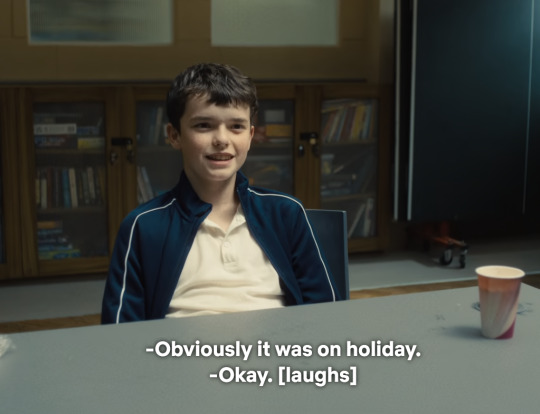
while also showing a childlike delight in having an easygoing, fun conversation with someone
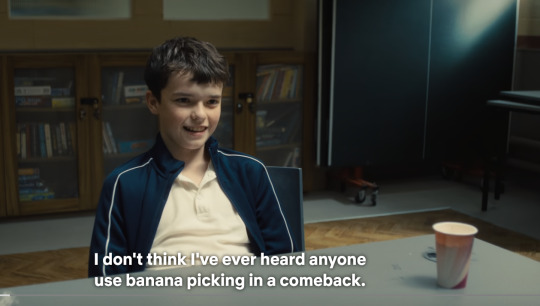

I also quite like the yawn now that I know that it wasn't intentional, Owen was genuinely tired and he yawned and Erin Doherty just went with it and ad-libbed her response

and Owen laughs and he's kind of giggly because he also didn't expect that ad-lib
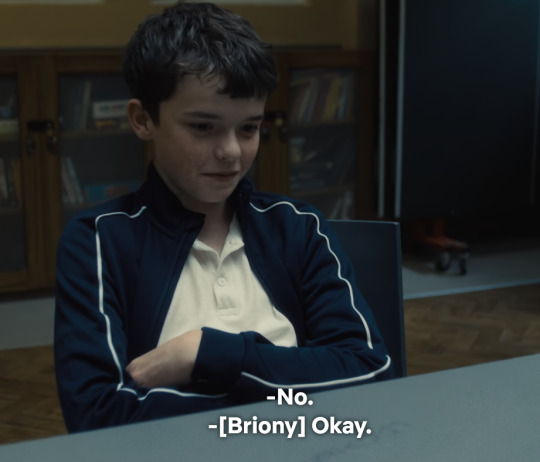

but Erin continues with her lines and so you see in a few seconds how Owen locks back into the scene, and gets back into the character

and it works for the entire dynamic between the two of them because I would not have guessed that that was what we were watching and it's a testament I think that he recovered so quickly.
When he does stand up and says, "What was that? Hey?"

he kind of mimics Stephen Graham's intonation and body language, which kind of showcases how he tries to model himself after different male role models, which includes his dad who he's very protective of and who isn't a bad guy but has harmful habits that Jamie's picked up on, so I thought was really well done.
And he's also good at facial expressions, derision
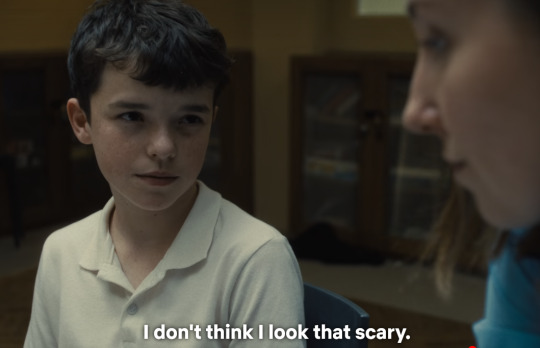
sadness
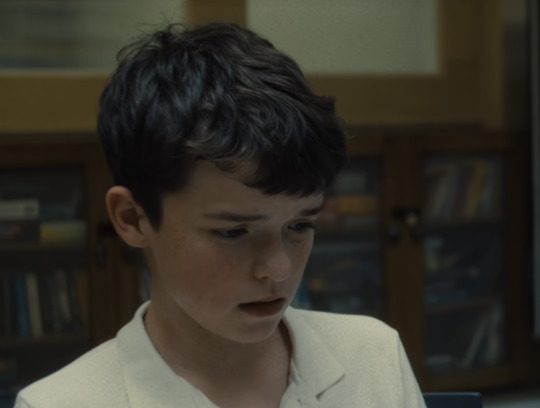
irritation/defensiveness

I also think when he panics and lashes out when Briony says that they aren't going to see each other anymore is really well done, the "Do you like me?" and "Tell my dad I'm alright"
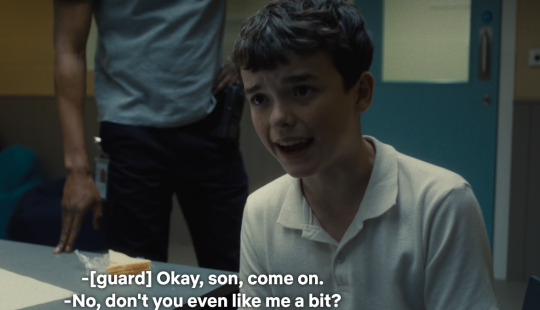
because there is a raw vulnerability there but he puts that in his performance after such a vile confession, which was also done really well because it's performed as beseeching, like even though the underlying message of his confession about how he felt is "that bitch deserved it" he doesn't play it with that kind of sinister tilt and he doesn't play it as emotionless and logical, he plays it as, if you just understand, if you just understand from my point of view, which is really chilling.
As for Erin Doherty, it's harder to discuss her even though she does so much because everything is so subtle with her, you can't get in screenshots but she was such a great scene partner and like I said, she does so much with her material because she's meant to be an impartial ear there to make an assessment but you see how she slowly shifts throughout their hour together with her tone especially, like when she comes back in after her first outburst, she's curt
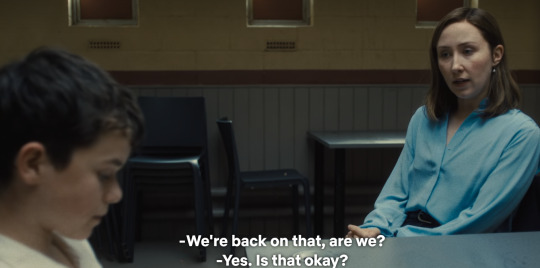
and her expressions change infinitesimally, because she doesn't show too much emotion because she's not meant to sway Jamie in any kind of way but for the audience (and sometimes for Jamie because he's bright and observant) we can see a very slight eye roll or sigh, we can she how she watches him, hopeful for any kind of sign so there can be mitigating factors to his crime

and then her realization when Jamie speaks about how he could've molested Katie's body but didn't and that makes him better, the disappointment and disgust and shock is communicated with a furrow of her eyebrow

or a very slight pursing of her lips and then the sort of release she has to do once he's left

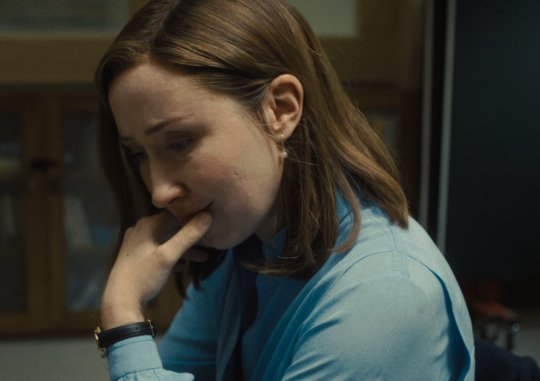
is such a great performance.
434 notes
·
View notes
Text
Some Advice for Beginner Witches/Advice I Wish I Got
I'm by no means an expert in anything magical or an expert witch, this is mostly just advice/tips that I wish I had had when I was first starting my practice OR advice that I think a lot of beginners could benefit from. Resources will also be linked at the end.
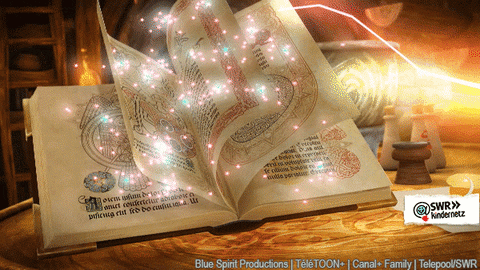
This is a rather long post so everything else is under the cut, but I've divided everything into general advice, spiritual practice advice, and community-oriented advice. Links to applicable sources are under Miscellanea.
General Advice/Things to Keep in Mind
Consider the mundane stuff first! Use naturally-sourced/biodegradable and ecologically safe offerings/magic components when working outside or if you're going to return something to the earth (ex. salt will kill plants/damage soil so don't do a salt circle- use crushed eggshells instead and don't bury anything non-biodegradable/naturally sourced), practice good fire safety (ffs every witchy person I've run across has at least 1 'fire incident'), make sure not to expose crystals to things they'll react negatively to (ex. pyrite in water will form sulfuric acid), etcetera etcetera.
You don't need to get all new specialty equipment or a ton of things to start your spiritual practice. You may want to but you by no means do you have to. A lot of everyday items that you may already have can perform magical uses, so just use the things you have until you run into specific items you may want to add to your practice (ie you might make an alter out of things you already have and then switch out elements with new preferred items as you get them). Honestly things might work better if you use older/mundane items you have a close connection to.
Similarly, you don't need to go and get the most expensive things for your craft either. If you're wanting to splurge on anything, splurge on safety supplies (fire safety supplies or anything that will make your practice more safe practically are good places to start) and workhorse items that you will be able to use frequently long-term. This doesn't have to be a major strain on your budget and shouldn't be a financial burden to you.
Magical/Spiritual practitioners DO NOT all believe the same things. Spiritual practices/Spirituality is more of an umbrella category that encompasses many different practices (or practitioner communities) rather than a specific belief system/community and most practitioners ascribe to schools of practice or systems of belief and combine those systems with their own unverified personal gnosis (typically called UPG). Overlaps in beliefs or practices happen fairly regularly, but will be different for different practices.
You can learn something from most practitioners, even if they come from a different belief system or practice (disclaimer: do not take from/try to practice closed practices/religions, I am not telling you to do that). By this I mean that other practitioners will probably have different bases of knowledge and perspectives that may be of help to you even if they come from a different type of practice. Personally, if I'm struggling with understanding a specific concept or I'm having issues linking something up within the rest of my practice, hearing someone else's viewpoint or seeing how they link/incorporate different aspects of their practice can be a catalyst for working through those issues
Take care of yourself. Look into spiritual psychosis and what to look out for, and and try to not fall down the rabbit hole of convert fervor. Most people are not expecting you to have your entire practice nailed down within the first week (tbh your practice will probably change and evolve throughout your life), so take your time and go at a pace that's sustainable for you. You'll probably even have rest/break periods of low/zero engagement in your practice, and if that happens that's fine too!
Magic Advice & Spiritual Practice Tips
I would recommend starting where you are most interested or start working with what you're most inclined towards. For example, don't start with candle magic if you're more interested in plant magic just because it's more recommended for beginners. You're more likely to be able to genuinely engage with and enjoy your practice if you have a connection with what you're doing. Personally I started with astrology and crystals, and then got into divination work with pendulums and tarot before expanding into everything else I do because that was the path my interests aligned with. Your path is probably going to be different, and that's great!
However, if you're looking for easy places to start, I do have recommendations based on how easy they are to access and incorporate into your everyday life. Kitchen witchcraft is pretty easy to start with assuming you already cook (or would like to learn how) and can become very intuitive once you have a good grasp on cooking and magic. Small bits of glamour magic or sigil work can also be easy to do since you're already bathing/clothing yourself (charming clothing and toiletries is fairly easy and beginner friendly). Cartomancy can also be a solid way to go, since a cheap or DIY'd tarot deck or a playing card deck can be fairly accessible for most people. Pendulums, runes, and bone throwing kits/magpie oracles can also be DIY'd easily or bought depending on your preferences.
Incorporate the knowledge and skills you already have! A lot of practical skills you may already have can be of practical application to your practice. I've also found that my magical understanding of concepts is deepened when I understand how things work on a mundane level.
Going along with that last point, I think skill building/skill use can have devotional applications (if devotional actions are part of your practice). Ex. if you worship a deity that is associated with craft or a particular skill, you can absolutely dedicate your pursuit of knowledge in that skill or dedicate a project to a deity/spirit of your choice. Alternatively, dedicate that skill building to yourself or your practice (for example, dedicate the creation of a homemade alter cloth to an alter or towards the growth of your craft/practice)
I have found that there's a lot of advice regarding cursing and doing magic when your experiencing heightened emotions. Personally, I'm curse neutral I don't really do them (I've just never felt the drive to) but I have no issue with them. Do as you will, but be prepared to deal with whatever consequences may arise (tbh this is good general advice for your practice). Regarding doing a working when you're in a heightened emotional state, I would just say in my experience that doing magic in that state can lead to impulsive actions or not thinking something through. Do whatever you're going to do, but maybe calm down or proceed with caution for best results is all I'm saying.
Sometimes the best thing to happen with a working is for it to fail. Maybe you were working with something you shouldn't (like a closed practice that wouldn't pertain to you), or it's something you wouldn't be able to handle, or maybe it's something that would end up being regrettable if it actually worked. There are a lot of reasons why something not working can be for the best, but that is sometimes the best outcome for a working (even if you don't realize it in the moment).
Look for ways to evolve your practice and think outside of the box! Experiment with new applications of different working (like glamour magic to be forgettable/unnoticeable instead of noteworthy), involve new components if they make sense (ex: enchant some ink if the working has a written component), or make your own correspondences based on how things work for you
I have found that location can effect a working quite a bit (and effect you if it backfires). One of the more helpful pieces of advice I've gotten is if you're planning on doing a bainful working/cursework/negative working, don't do that where you live/exist regularly (like your job). Like, if you're wishing bad luck towards someone you don't want to have it backside on you where you sleep and live (working off property at least or at a crossroads world be ideal in this case). Similarly if one was to do a beneficial spell regarding sleep, do that at your home in your bedroom.
This also applies to community advice but: if you come across someone else's working, I would advise that you not tamper with it unless you have to. Beyond not knowing what it's for/affecting, the working may have hazardous components you aren't aware of (sharp bits, mold, toxic/allergic reaction causing substances, etc)
Community Advice & Relationship Building
Like any group of people, magic/spiritual communities can have bad/malicious actors within them, typically in the form of grifters, different types of alt-righters, and cults. I would recommend learning to spot and avoid alt-righters and nazis quickly as the alt-right loves magic & occult spaces and they will try to recruit or radicalize you if they get the opportunity. Familiarizing yourself with ways to spot grifters, red flags for cults, and common symbols/red flags of by the alt-right in magic/ occult spaces is important (learn quick and early and then stay up-to-date on that information for the safety of yourself/others).
You can make your practice as private or collaborative as you'd like, but having friends or community connections is nice! Being friendly and polite will generally go a long way to meet people and see if you would want to try to form connections within different practitioner communities online and offline.
In person locations/events might be a good but unreliable venues for meeting local practitioners, getting supplies, and learning new skills for your practice. Your local shops (depending on availability in your area) will probably have a mix of customers, but there's a decent chance there are regulars that you can meet and maybe form relationships with as well. Metaphysical shops, independent groups, and even areas/towns will also sometimes put on events/meet-and-greets/workshops that can be a fun way to connect with practitioners in your area.
Being friendly and respectful will get you pretty far with creating relationships in different magical spaces/communities. Reaching out to other people (online or irl) can be a good way to network and learn new things
Miscellanea
The Witch of Wonderlust's offering cardigan video here. She also has a plethora of educational videos on her youtube channel
Frankie/ChaoticWitchAunt on youtube also has done good educational content. They primarily do Italian-American folk magic and tarot and I've learned quite a bit from them
@breelandwalker and her show Hex Positive are also wonderful resources.
@friend-crow and @windvexer are also two great witchcraft bloggers
thetarotguide.com has some great guides for the Rider-Waite-Smith tarot cards, the card guides are quite detailed and well written. There is also a small but not insubstantial community of tarot/oracle reviewers on YT that is a nice resource if you are wanting to get a new deck
I've also found the work of Jason Miller to be quite informative. Miller had published multiple books and what I've read of his work had been quite enlightening.
Not to plug my own stuff, but my #tarot musings tag, my witchy recipes, a workshopping correspondences post, charm necklace post, and star jar workings might be some fun and easy places to experiment. I also quite liked my
For more experienced people, please add any advice you'd want beginners to know! For beginners, I hope this helps a bit! Thanks for reading💜
228 notes
·
View notes
Note
hey! i was wondering if you had any advice for writing a "bully" tough guy character with a hidden heart of gold that will be redeemed later on in the story? i wanted to have their motivation being seeing their bullying as making people stronger (for maybe a reason like from being bullied for being weak themselves) but idk how i would begin to write this
How to Write a Bully with Opportunity for a Redemption
Establish a Compelling Backstory
Bullying History: Flesh out the character's past. Perhaps they were bullied themselves, leading them to believe that by bullying others, they can instill strength and resilience. This creates a cycle of pain that they think they're breaking.
Family Dynamics: Consider their family situation. Maybe they have a tough home life that forces them to adopt a hard exterior, believing vulnerability is a weakness.
Defensive Mechanism: Make it clear that their bullying is a defense mechanism. They may fear being seen as weak or unworthy, so they project toughness to avoid being hurt again.
Create Layers of Personality
Contradictions: Show moments where the tough guy’s softer side shines through, such as helping someone in a subtle way or expressing empathy toward a friend. This builds intrigue and hints at their hidden depth.
Hobbies or Interests: Give them a passion that contrasts with their tough exterior, such as caring for animals, art, or even an interest in literature. This helps humanize them and shows they have more to offer than just their bullying behavior.
Develop Strong Relationships
Friendships: Explore the dynamics of their friendships. Do they have a best friend who sees through their tough exterior? This friend can be a source of support and also push the character toward redemption.
Conflict with Others: Show how their bullying impacts their relationships with other characters. This can create tension and give other characters a reason to want them to change.
Establish Their Motivation for Bullying
Internal Monologue: Use the bully’s thoughts to explain their perspective. Allow them to rationalize their behavior with phrases like “I’m just toughening them up” or “They’ll thank me later.” This internal justification provides insight into their mindset and shows that they genuinely believe in their method.
Dialogue with Others: Show conversations where the bully explains their philosophy to friends or peers. They might say something like, “You have to be tough to survive. I’m just giving them a reality check,” or “Weakness only gets you hurt.” This can illustrate their conviction that they’re helping rather than harming.
Interactions with Victims: When the bully interacts with their victims, allow moments where they express a twisted sense of encouragement. For instance, they might say something like, “You’ll thank me when you’re stronger,” or give unsolicited advice on how to handle being bullied, further solidifying their misguided belief.
In-Scene Justification: As the bully corners a victim, they might say, “You think this is tough? You should’ve seen what I went through. I’m making you stronger. You’ll thank me when you can stand up to people like me.”
Aftermath Reflection: After an intense encounter, the bully reflects, “Maybe I pushed them too hard. But if they break now, they’ll never survive out there. I can’t let them be weak.”
Confrontation with a Mentor: In a scene with a mentor or friend, the bully might insist, “I’m not a bad guy. I’m doing this for them. They need to be ready for the real world. They’ll understand one day.”
Build Moments of Realization
Catalyst for Change: Identify key moments that can serve as turning points for the character. Perhaps they witness the consequences of their actions firsthand, such as a target of their bullying breaking down.
Moment of Kindness: Have them perform a small act of kindness that contradicts their tough persona. This could be something like defending someone who’s being bullied or comforting a classmate in distress.
Craft a Redemption Arc
Struggle with Self-Perception: As they start to recognize their wrongs, explore their internal conflict. They might grapple with feelings of guilt or shame, unsure how to change.
Facing the Consequences: Introduce scenarios where they face the repercussions of their past actions. This can lead to a moment of humility, where they apologize or make amends.
Support from Others: Allow other characters to help guide their transformation. Perhaps someone who was bullied approaches them and expresses that they see potential in them, encouraging a new path.
Highlight the Heart of Gold
Acts of Courage: In the climax, have them step up to protect those they’ve bullied, showcasing their newfound understanding of strength and vulnerability.
Positive Impact: Illustrate how their change positively affects others. This can be through friendships, mentorships, or even inspiring other characters to change as well.
End on a Hopeful Note
New Identity: Conclude the character's arc by showing them embracing their softer side while still retaining the tough-guy persona, proving that they can be both strong and kind.
Forgiveness: Allow for forgiveness from those they’ve wronged, reinforcing the theme of redemption and growth.
Example Character Arc:
Initial Setup: Jake is known as the school’s tough guy, bullying anyone he deems weak, believing it will make them stronger.
Backstory Reveal: Through flashbacks, we see Jake bullied mercilessly for being small and weak, leading him to adopt his aggressive persona.
Turning Point: After witnessing the severe impact of his bullying on a classmate, Jake begins to reflect on his actions.
Redemption Moment: In a climactic scene, Jake defends the same classmate from a new bully, proving he’s changed.
Resolution: By the end, he’s mentoring younger students, using his experiences to help others find their strength rather than tear them down.
#writing prompts#creative writing#writeblr#story prompt#prompt list#ask box prompts#angst prompts#how to write#how to write a bully#how to write a bully with an opportunity for redemption#how to write a redemption arc#redemption arc#writing tips#writing advice#writing help#writing resources#on writing#writing tools
501 notes
·
View notes
Text
Degree Theory Series: The Leo Degrees (5°, 17°, 29°): Unveiling the Complexities of Power, Prestige, and Presence

☆ Leo degrees represent a striking influence—one that combines ambition, charisma, romance, and a near-magical allure. The house that Leo is in your chart is reflective of the area of life that you have the potential to receive a lot of attention. It is literally the sign of reaching for the stars. But beneath the well-known themes of fame, leadership, and power, these degrees have deeper, sometimes hidden qualities that shape the lives they touch. Here’s an exploration into these powerful degrees, plus the distinctive flavors they create when combined with different planetary energies.
5° Leo: The Catalyst for Expression and Presence
Keywords: Bold action, self-expression, initiator, elite status, teaching and guidance.
☆° ✩࿐
Personality and Physicality: Known as a degree that heightens presence, 5° Leo lends a dignified, commanding air that can be quite magnetic. David Hasselhoff’s for example has a Venus at 5 degrees of Leo. Back in the day, David was known for his magnetic charm and stage presence. He had set the Guinness world record of the most watched man on Tv. This degree supports his appeal as the central figure of Baywatch, Knight Rider and other things, and it shows his ability to thrive under the spotlight. He had set the Guinness world record of the most watched man on Tv.
5° Leo isn’t just the “leader” degree; it often marks those who naturally attract authority and influence without having to seek it.

Hidden Quality of Resourcefulness: A lesser-known quality of 5° Leo is its connection to resourcefulness in high-stakes situations. Those with this degree on key planets often discover remarkable ingenuity under pressure, especially in challenging or isolating circumstances. To thrive in the spotlight, you have to be very resilient.
17° Leo: The Degree of Visionary Influence and Endurance
Keywords: Legacy, public service, intellectual pursuits, mentorship, teaching roles, family connections.
Social Reach and Legacy: 17° Leo reflects someone whose influence extends over time, resonating through a legacy, particularly through teaching, law, or service roles. the 17th degree is the 2nd highest degree amongst the leo degrees (5, and 29 are the other leo degrees) meaning that it has a “longevity” behind it. There’s often a connection to mentorship or guiding others, and those with 17° Leo placements may be naturally drawn to academia, justice, or philosophical pursuits. They often think in terms of generations and long-term impacts.
Oprah has her MC in 17 degree of Libra.

Elvis Presley is a prominent example of a celebrity with a 17° placement, specifically with his Sun at 17° Capricorn, which is influenced by the “Leo degree” due to degree theory. This degree is associated with lasting fame, a magnetic stage presence, and the ability to create legacy and extend over time. Elvis Presleys music has the ability to transcend time—this aligns with Elvis’s legendary status as the “King of Rock and Roll.” The 17° Leo degree amplifies qualities like charisma, recognition, and impact in the public eye, traits strongly reflected in Elvis’s career and enduring influence in music and culture.

Another example is George Michael, whose Ascendant is at 17° Cancer, lending him a path aligned with Leo qualities—drawing attention, captivating fans, and excelling as a charismatic performer in the entertainment industry. Both figures illustrate how the 17° Leo degree enhances the potential for significant, long-lasting public impact and memorable artistry.
These cases highlight how the 17° degree is seen as one of prestige and enduring influence in charts of famous figures, marking individuals with an aura of distinction and an ability to maintain a lasting legacy in their field.
The Role of Family and Support: This degree frequently connects individuals with family lineage, both in values and sometimes through inheritance or positions of responsibility within family networks. The “father” degree, it suggests an ability to support or uplift family lines or nations—carrying a certain gravitas that inspires collective respect. Just as 17° Leo was prominent in Bill Clinton’s chart, it speaks to enduring influence, as well as the idea of a “national father figure.” Again with Presley he was considered the Father or King of Rock and Roll.
Lesser-Known Influence in Social Structure: Lesser known is 17° Leo’s gift for navigating social structures, from rallying support to surviving intrigue. Individuals with this degree may exhibit a resilient streak, successfully facing threats or challenges within power structures=Much like Elvis who did receive multiple death threats and kidnap warnings, particularly while performing in Las Vegas.
29° Leo: The Degree of Transformative Leadership and Strategic Vision

Keywords: Finality, transformation, intuition, covert planning, prestige, challenging circumstances.
Mystery and Power Dynamics: Known as an “anaretic” degree, 29° Leo carries themes of completion, change, and high-stakes decisions. People with this degree tend to face intense personal or public challenges that demand creative problem-solving and often put them in complex or strategic roles. A bit of a “chameleon” degree, it suggests someone who can operate under the radar and emerge victorious, often as a reformer or innovator within traditional structures. Leaders like Winston Churchill, who had his Moon at 29° Leo, epitomize the strength of this degree. Similarly, Donald Trump's 29° Leo Ascendant underscores a charismatic presence and his controversial but impactful role in the public sphere, navigating complex political power structures. They guy became the president of the United States at one point and is up for office again.
Transformation and Symbolic Rebirth: 29° Leo may indicate the ability to work behind the scenes or in covert ways, potentially in intelligence, diplomacy, or advocacy roles where resilience is paramount. Often, individuals here face life events that force them to “become someone new,” such as a leader rising unexpectedly or a figure dealing with transformative personal setbacks. Just as Churchill rose during Britain’s darkest hour, those with 29° Leo can emerge from crises as symbols of strength and change. his degree also enhances adaptability, suggesting a capacity to emerge stronger after setbacks or public scrutiny. This is also seen in Drake (BBL Drizzy) and Heidi Klum, both with Ascendants at 29°, which contributes to their enduring relevance and adaptability in the ever-changing entertainment landscape.
Lesser-Known Themes of Hidden Loyalty: There’s also a lesser-known aspect of loyalty and readiness to defend others, even to the point of self-sacrifice. This degree attracts followers or allies who support them in unlikely ways, often during critical transitions or public shifts.
Planetary Combinations:
Mercury at 29° Leo: Mercury here indicates someone who speaks with finality and influence, often giving speeches or communications with a lasting impact. They may find themselves in pivotal discussions, historical moments, or transformative media.
Pluto at 29° Leo: This pairing suggests a powerful leader who can influence others profoundly, sometimes by overturning existing power structures. Pluto at 29° Leo is highly transformative, especially in public roles, and may attract both fame and intrigue, giving the individual an almost mythic quality.
Uranus at 29° Leo: With Uranus, there’s a push for radical change and an ability to innovate under pressure. Individuals with this placement can disrupt the status quo effectively and are unafraid to act independently, even if it means losing support temporarily. Their vision is ahead of its time, and they may be involved in pioneering work or historic moments of change.
Hidden Qualities Across the Leo Degrees
Each of these degrees in Leo also carries unique subtleties, especially when it comes to handling public pressure, love for prestige, and overcoming personal trials. Whether seen in how they survive adversities (often with an unexpected inner resilience) or in their commitment to their people or causes, Leo degrees add depth and charisma that’s impossible to ignore.
If you hold one of these degrees in a major placement, consider it a call to embody love, loyalty, and leadership in your unique style. The Leo degree asks for authenticity and confidence, even when the stakes are high.
Observation:
Sun at 5° Leo: A classic position for leaders who are highly visible and admired. The Sun here drives an ambition that others respect, even if they don’t fully understand the drive behind it. There’s a fierce desire to succeed on one’s terms, often in high-profile careers or pursuits.
Moon at 5° Leo: Emotional expression is vital here, with a need to connect in visible, memorable ways. A Moon at 5° Leo can feel happiest when making an impact in social or familial spheres, perhaps guiding or inspiring others. There’s a special talent for evoking loyalty and support from people, often based on an instinctive understanding of group dynamics.
Mars at 5° Leo: Mars here is a warrior spirit that fights with purpose. It’s often associated with a physical stature or confidence that commands space, possibly leading to military or athletic pursuits. There’s a heightened ability to rally others, leading to leadership roles that arise naturally in tense situations.
#astro observations#astrology#astro placements#natal chart#zodiac signs#persona chart#astro notes#astrology observations#asteroids#degrees#astro community#astrology notes#astrology blog#astro tumblr#astroworld#12th house stellium#stelliums#planets#sun#moon#gemini#5th house#mercury#draconic chart#venus#ascendent#uranus#saturn#neptune#jupiter
793 notes
·
View notes
Text
real talk though!!! Dichen Lachman's performance. the whole entire show, everything that Severance is, stems from the catalyst that was Gemma's death. She and Mark's love for her are the driving force behind it all. He wouldn't be there if not for the fact of her death. Petey wouldn't have had Mark to seek on the outside if not for the fact that Mark was so broken up by her death that he split his brain in half. That he would stitch it back together at the risk of his own death just to see her again.
That creates a huge, huge responsibility in finally presenting Gemma to the audience. They had to show us a person and a love that is so enduring that it would create the Mark that we've gotten to know, or else the whole entire premise falls in on itself. And they delivered!! Dichen Lachman plays a Gemma that is so charming, and confident, and smart, and so, so rounded. In a single episode we see the kind of drive that carries her, the things she falls in love with. In a single glance and barely a line of dialogue between Gemma and Devon, we can see the whole depth of their friendship. We know what she's scared of. We know that even her innie has moments of rebellion, that she refuses to live without seeing answers, that she lets her sense of hope push her forwards. In a single episode, a season and a half into the show, we've finally met Gemma and immediately it clicked why someone would walk right down into hell just to get her back.
#dichen lachman. we are getting you an emmy#god. i started crying when it was clear Milchick was going to make her go back#severance#gemma scout#severance spoilers#q watches severance
324 notes
·
View notes
Text
Who is the Antler Queen? A Theory Deep Dive
The identity of the Antler Queen has been a mystery at the heart of Yellowjackets since the pilot, and in the time since fans have speculated about many possible candidates. But there’s one in particular that’s been rapidly gaining traction in the fandom: that the Antler Queen is none other than everyone’s favourite lesbian ghost, Jackie Taylor. With the launch of Season 3 I wanted to delve deeper into the idea and why I think it would make perfect sense for the series, especially after the latest two episodes. Cork boards and post-its at the ready folks, this is gonna be a long one. And of course, spoilers.

I’ll start off by referring to this Vanity Fair article from 2023, which gives a succinct rundown of this theory. To summarise, it posits that the Antler Queen as an individual doesn’t exist, per se, and is instead a manifestation of the girls’ collective perception of ‘the Wilderness’. This would track with what’s been established in the show and how the Antler Queen has been framed thus far; as an esoteric, supernatural figure that haunts the narrative in a similar way to The Man with No Eyes in Tai’s storyline - or indeed, the figment of Jackie in Shauna’s. The Wilderness is already personified extensively by the girls owing to Lottie’s visions and the religion that sprouted around it, referred to as a sentient entity with a will of ‘its’ own.
This is where Jackie comes in. Jackie as a character, from the very beginning, is defined not by who she actually is or was, but by how she is perceived - by both herself and those around her. Jackie is the first character we’re formally introduced to in Yellowjackets, and the scene is centred on her performative pleasure for her boyfriend Jeff while looking utterly miserable. We immediately cut to her aggressively brushing her teeth before clutching her iconic heart necklace with a forlorn expression. Her reflection is split across several mirrors, symbolising her fractured self and the many roles she plays, none of which are a truly accurate representation of Jackie the person.


The smitten high school girlfriend (who can’t stand her boyfriend), the queen bee who has it all (who is unfulfilled and lost when nobody's looking), the charismatic soccer captain (who is constantly undermined by her team), the self-centred, stifling best friend (who loves Shauna more than anything). Later she’s the pariah (who was one of the few remaining voices of reason), the first sacrifice (who never believed), the dearly departed teenage girl who so loved rabbits (she was indifferent to them at best). In death, as in life, Jackie is forever condemned to be what others make of her. That’s the inherent tragedy of the character, to never be truly known, to be an idea more than an individual.
Secondly, Jackie is often described as the embodiment of civilisation’s values in Yellowjackets, but she is also the unwitting architect of the Wilderness’ new status quo. Out of everyone, it was Jackie who committed the first act of brutality after they crashed: leaving Van to burn alive to save Shauna. This was long before anyone had descended into savagery, and set a precedent for the Yellowjackets as a whole. Although her intention was to grasp onto some semblance of normality and bolster team morale, Jackie also sowed the seeds of the spiritual practices they would go on to adopt. It was Jackie who organised the séance, in doing so triggering everyone’s first exposure to forces beyond their understanding as Lottie is seemingly possessed by the spirit of Dead Cabin Guy. It was Jackie who came up with the idea of Doomcoming where, with the help of some hallucinogenic shrooms, the girls surrendered to their most primal selves and attempted to ritually sacrifice Travis. And of course, Jackie’s death is a paradigm shift where the old order crumbles to make way for a new one - and so passes the glory of the world.

After her death, Jackie continues to be a catalyst for the Wilderness’ machinations. She is the first person to be cannibalised, marking a point of no return for the Yellowjackets. Unlike the bleak horror of eating Javi, Jackie’s consumption is a heightened, ritualistic affair, presented as a bacchanal feast - a religious festival. In one of the rare cases of the camera assuming the perspective of the Wilderness, the wind rushes through the pines, blowing the snow perfectly onto Jackie’s funeral pyre and cooking her corpse. As the starving Yellowjackets congregate around her charred body later that night, Shauna says, “She wants us to.”


Jackie is portrayed posthumously in much the same way as the Wilderness itself: even though she has no voice, a will is ascribed to her. It’s important that Shauna is the one leading this. Although she doesn’t buy into the mysticism like Lottie and many of the other Yellowjackets, Shauna instead envisions Jackie as her personal saint (“They were all so tragic”) and tormentor. There is every possibility that this season, either spearheaded by Shauna or in spite of her, ‘Jackie’ will become the figure the Yellowjackets worship, too.
Lastly, there’s a heavy amount of foreshadowing and symbolism lending to Jackie as the Antler Queen. The obvious being that she was the Yellowjackets’ team captain. As the Vanity Fair article points out, Coach Martinez’ words to her in the pilot could well be more than dramatic irony: “You possess something no one else on this team has: influence. When things get tough out there, those girls are going to need someone to guide them.” We even see this called back to in ‘It Girl’ when Lottie says, “We call to Jackie, now with the Wilderness. Guide us.”


Then there’s the vision Jackie experiences before she dies, surrounded by doting teammates expressing their admiration, cloaked in a blanket beneath the antlers suspended above the cabin’s hearth. It’s all she ever truly wanted, to be loved and seen for who she was. How tragically poetic, then, would it be for her to finally receive the adoration she craved in death as a bastardised and diefied version of herself.

And of course, there’s the necklace. To Jackie it was a symbol of protection and her love for Shauna, but we know that it ultimately comes to be worn by those ‘chosen’ to be hunted by the Wilderness. Shauna initiated this with Nat, who continues to wear it after being crowned the first leader of the survivors. This practice of being marked for leadership or death by the necklace is an extension of Jackie becoming mythologised by Shauna and the rest of the Yellowjackets. Again, the line between ‘the Wilderness’ and ‘Jackie’ is blurred.

Let’s look at the show’s promotional material, a lot of which heavily features Jackie throughout the series. The main poster for the first season features a dirty and dishevelled Jackie sporting a bloody nose while a single yellowjacket wasp perches on her cheek. What’s often missed, however, is the reflection of the Antler Queen in her left eye. This symbolises Jackie as a victim h(a)unted by the Wilderness, but it could mean something even deeper than that: the living, real Jackie could be staring at a dark mirror of herself.

A poster for the second season again features Jackie’s face, only this time that of her frozen corpse. Here there are two yellowjackets perched on her lips, and she’s wearing her heart necklace.

Another poster for Season 2 depicts the Antler Queen standing ominously in the snow. She’s wearing a Yellowjackets varsity jacket, cuffed jeans, a sweater, and a pair of sneakers. While some details are different (the sweater being black instead of striped and the sneakers being pink instead of white), the basic outfit bears a striking resemblance to the clothes Jackie was wearing when she died.

A teaser video for the third season shows a dirty skull carved with the Wilderness symbol. Three yellowjackets buzz around it, and Jackie’s necklace hangs from its right eye socket. In this context, it’s safe to assume that this is Jackie’s skull, especially as we know that the girls retrieved and buried her bones offscreen between seasons. We’ve already seen Shauna tamper with and project onto Jackie’s remains, and it isn’t that far-fetched to see them repurposed in that way once again.
youtube
Finally, let’s look at the recently released poster depicting the Yellowjackets dancing around a fire. Note how all of the main girls are here, including Nat, Lottie, and Shauna (the main living candidates). The implication here is that the Queen’s identity can’t be attributed to any single one of them. Maybe it’s a rotating role, but it also lends credence to this idea of the Queen being a construct. There are three skulls burning in the fire, representing those of the fallen - Javi, Jackie and Shauna’s child (Laura Lee and Crystal’s remains aren’t exactly accessible, after all). From the flames rises the figure of the Antler Queen: symbolically, she is born from the remains of the dead, and she’s burning just as Jackie burned on the pyre.

With all of this in mind, I think there’s plenty of solid evidence to suggest that Jackie’s bones could end up being repurposed into some sort of effigy, mounted on a stick, adorned with locks of hair and a veil fashioned from a soccer net, and crowned with a pair of antlers. Jackie would finally lead the Yellowjackets in a way she never could while alive.
In conclusion, despite her death relatively early in the series, Jackie’s presence looms large over Yellowjackets. She remains an integral part of its iconography, its themes, and Shauna’s character (the closest the show has to a de facto protagonist). After her agency, body, and legacy have been repeatedly consumed, appropriated, and warped throughout the series, it would be a natural evolution for the Yellowjackets to fully transform everything Jackie was in making her their idol for the Wilderness. It’s human nature to anthropomorphise what we don’t fully understand, to give it a face and a name. It’s also human nature to deflect the responsibility for monstrous acts to avoid looking at the monster within ourselves. For most of the characters, this is the Antler Queen. But Shauna will only ever be able to see the girl she loved, the embodiment of her guilt. Perhaps, somehow, the true Jackie will finally find a way to reclaim her agency and personhood through that. There is no ‘it’ there’s only ‘us’. But is there really a difference?
#yellowjackets#yellowjackets spoilers#yellowjackets season 3#jackie taylor#antler queen#yellowjackets season 3 spoilers#antler queen jackie#shauna shipman#lottie matthews#jackieshauna#meta#yellowjackets theories#just posting my wild theory here as well#I have more to say but I’ll make a follow-up post because this is long enough already
298 notes
·
View notes